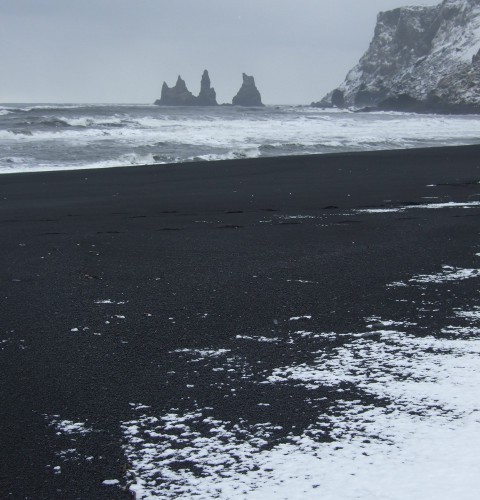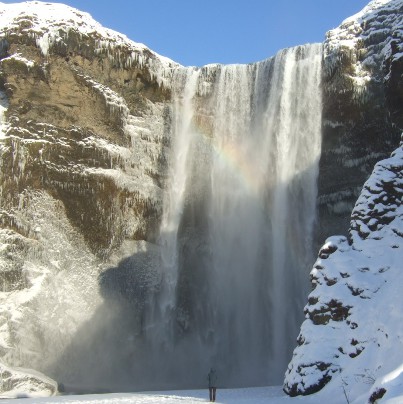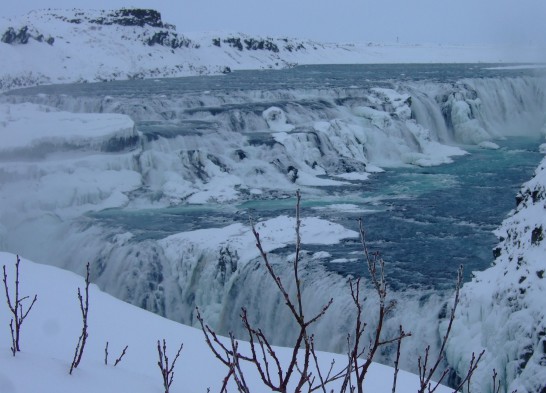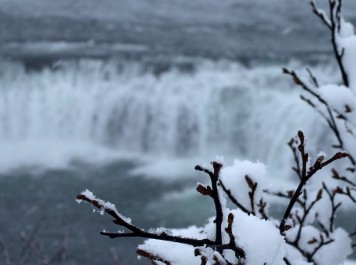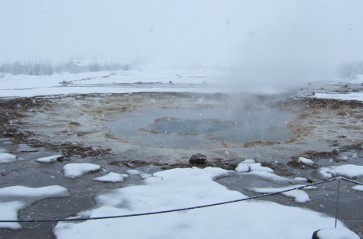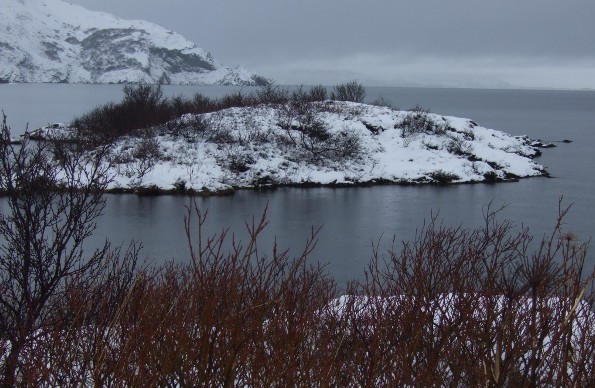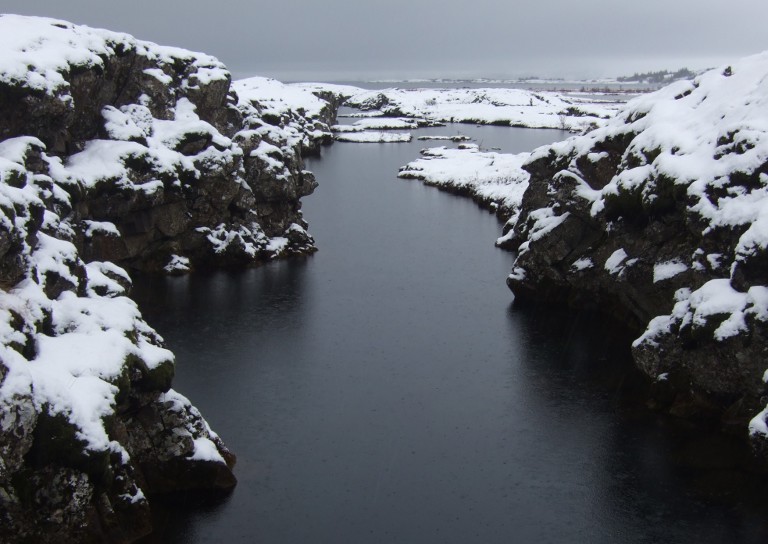That morning of our fifth and last day’s journey was radiant: the sun shone on the white blanket covering the land, emphasizing, by contrast, all the colours around: the deep blue of a nearby lake, the dark grey line of the sea to the southeast and the hazy azur of the glacier peaks to the west. Probably such a good location and nice environment was what inspired the farmers at Hvoll hostel to open that business they were so unfit for. Good locations are, quite often, the only resource of opportunists.
Thanks God the snow on the road was friendly packed down, and we merrily drove away from Hvoll, stopping two or three times for taking pictures or having a quick lunch. But by the time we arrived to Vik–the last town in the lonely south–the weather was already overcast with scatterd, moderate snow showers.
The legend goes that there were in Vik three trolls named Skessudrangur, Laddrangur and Langhamar, who found a masted ship on the sea and tried to pull it during the night into the shore, but before they managed to the beach, dawn came and they were stricken by sunrays, thus turned into rocks where they still can be seen today: the group of rock stacks called Reynisdrangur, which is the worthiest highlight around Vik. From the desolate beach the view is astounding: in the foreground, a stripe of pure white snow; secondly, the strikingly black volcanic sand; farther, the whitish foam formed by the raging waves; and lastly, in the background, the black Reynisdrangur contrasting against the grey sky.
It wasn’t so straightforward to find a open wifi spot in Vik to check the weather forecast. At the store–one of those places I like so much, quite common in scarcely populated regions, often the centre of local life, gas station, stopover, cup of coffee, homemade soup, friendly staff, laid back atmosphere–but there was no internet, and they sent us to the post office; but this was expensive, so we went to the youth hostel, where I knew they would be pleased to help us. And indeed they were: the friendly receptionist welcomed us to sit at the lounge and use their wifi.
The forecast for the rest of the day was: overcast with occasional and light snow/rain showers, temperatures a bit warmer. Nothing to be afraid of, except if we got wet snow on the pavement. Actually, a road in the Golden Circle was tagged “impassable”, but we didn’t worry too much because the Circle is very touristic and roads get constantly cleaned by snowploughs.
A few leagues to the west of Vik there is Skógafoss waterfall. With its 25 m width and 60 m height (like a 20-storied building) it is one of the largest in Iceland, and the spray it constantly produces creates a permanent rainbow when in sunny weather. Millions of years ago, its edge was a cliff of the coastline and the water fell right onto the ocean, but since then the sea bottom has raised and now constitutes the island’s southern lowlands.
There is another legend (Icelandic folklore is full of them), that the first viking settler in the area buried a treasure in a cave behind the waterfall. Years later, locals found the chest with the treasure, but they were only able to grasp the ring on the side of the chest before it disappeared again. The ring was then used for the church door. Which is a boring legend, I’m sorry.
The last hours of our Icelandic tour were devoted to the well known Golden Circle (or Golden Triangle), which consists of a few tourist attractions some one hundred kilometres east of Reykjavik. First we visited Gulfoss, a cascadel in the course of the river Hvítá which has two stages: first it falls down in three steps arranged along the river axis, and then abruptly plunges into a crevice 32 m deep, 20 m wide and 2.5 km long. When approaching the fall, the crevice is hidden from the view, and it looks like if the mighty river were simply swallowed by the ground.
Right by the view point there is a large hall featuring a souvernir shop and a restaurant, where the best lamb soup in the country can be ordered. Quite a classic, absolutely recommended. Besides, as you can have seconds for the same (unexpensive) price, it makes for a filling and delicious meal.
Next we went to the geysers. The word geyser comes from Geysir, which is actually the proper name of one of these natural, geothermal sprouts of water in Iceland. There are several of them around the area, each with a different name of its own; but Geysir was the first ever appearing in print and therefore the earliest known to Europeans, who took the word for the phenomenon. In turn, Geysir means “to gush”. Most of the others in the Golden Circle sprout only once every several years (or decades!) The only one coming every few minutes is Strokkur, therefore the most photographed. Unfortunately, it was painful to wait frozen handed, camera ready, for Strokkur to sprout, and difficult to take a nice shot; so, we didn’t take much pains for a decent photograph. But believe me, it’s quite a spectacle.
But what I found extremely interesting was to peep down inside the depths of their bottomless cauldrons, which are like pots of crystal clear waters, smoking and smelling sulfur. When I leant onto the brim of a well, I couldn’t help the dizzy feeling of being at the edge of an abyss through which it might be possible to see the lava–or is the lava watching us through these watery eyes? And my fantasy rockets to Jules Verne when I try to think to which depths this water goes? Does it kiss the magma lips down there? How would it be to dive in one of these holes? It’s amazing how can so much life exist and tread the extremely fragile crust of earth, forgetful of the colossal ball of fire we’re sitting on. Iceland itself isn’t but a crevice in this crust, where the earth shows its igneous, incandescent entrails; which is a bewildering thought.
We also visited the Thingvellir, the old parliament, which was the ruling council of the first settlers before they submitted themselves to the Crown of Norway; and also the scenic Thingvallavatn, the largest lake in the country, though by that time daylight had become so dim that every object covered by snow was reliefless.
This was our tour along the Ring road, around Iceland. But before finishing this last chapter let me tell the short story of one errand we had to do: Benito had been entrusted in Madrid with delivering a bottle of Spanish wine to a lady in a village not far from Reykjavik, in Selfoss district; but he had been given no address: just the lady’s name and her village, which in Iceland should be enough, he was told. Unfortunately, some letter in the village’s name must have been misspelled by the remitent, because we weren’t able to find it on maps or the internet: we scanned the whole Selfoss area for names similar to the one we wanted, but the closest we got was Skálholt, and even locals had never heard of the place we asked. So, being our only candidate, to Skálholt we went with the bottle. It is a tiny little village and all lights in the houses were off, like if everyone had gone to mass; but for one home, and this doorbell we rang. A lady opened the door (the only Icelandic person I’ve known to speak no English), but she was obviously not the addressee of the gift. So, having no time for further inquiries, we had to give up and drink the wine ourselves. Which is a boring story, sorry.
On our way back to Reykjavik we still bumped into some snow heaps on the road, almost invisible in the dusk; as a matter of fact, we were very close to getting stuck again. But by this time the reader will be as familiar with such things as we were, and this new story would be of as little interest for you to read as it would be for me to write, so I’ll spare it. Suffice to say that, once in Reykjavik, sound safe after this eventful trip, we indulged ourselves to the one and only, the unique, the inimitable lobster soup in Saegreifinn.


